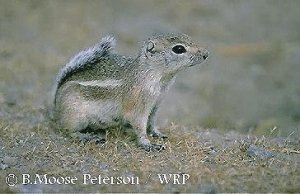Endangered Species Recovery Program | |
|
Home | News | Publications | Species profiles | Data and maps | About | Staff | Links | Department of Biological Sciences | CSU Stanislaus |

San Joaquin antelope squirrel
Ammospermophilus nelsoni
Status
California Threatened Species (federal species of concern)
Life History
The San Joaquin antelope squirrel is a small ground-dwelling squirrel with tiny rounded ears and relatively short tail and legs. It is light brown in color with a light-colored stripe on each of its sides. The tail is light gray or whitish on the underside and is usually held in a vertical position when sitting or curled over the back when running.
This species inhabits the arid grassland, shrubland, and alkali sink habitats of the San Joaquin Valley and adjacent foothills. The squirrels are active year-round and live in burrows that are either modifications of kangaroo rat (Dipodomys spp.) burrows or ones the squirrels constructed themselves. They are omnivores whose diets are dependent on food availability. Items consumed include green vegetation, fungi, seeds, and more commonly, insects.
The antelope squirrel's breeding season is from late winter to early spring. Gestation lasts approximately 26 days and the young are born between March and April. Young are first seen above ground when they are about 30 days of age. Information on the dispersal of the young is scarce. The life span of the antelope squirrel is usually less than 1 year; however several individuals have lived in the wild for greater than 4 years.
Distribution
Historically, the San Joaquin antelope squirrel ranged from northwestern Merced and eastern San Benito counties south to the northern border of Santa Barbara County. Prior to cultivation, the area within which this species was distributed was approximately 3.5 million acres. In 1979, an estimated 680,000 acres of uncultivated habitat remained and only about 101,962 acres was of fair to good quality.
Present populations can be found at elevations of 50 meters (165 feet) on the floor of the San Joaquin Valley to around 1,100 meters (3,609 feet) in the Temblor Mountains. In 1979, substantial populations were located within the areas around Lokern and Elk Hills in western Kern County and on the Carrizo and Elkhorn Plains in eastern San Luis Obispo County. Since 1979, San Joaquin antelope squirrels have disappeared from many of the smaller habitat clusters on the Valley floor.
Loss of habitat due to agriculture, urbanization, and petroleum extraction and the use of rodenticides for ground squirrel control are the primary threats to the survival of the San Joaquin antelope ground squirrels.
Classification
Order Rodentia, Suborder Sciuromorpha, Family Sciuridae, Genus Ammospermophilus, Species nelsoni
Subspecies
None
Recent Synonyms
Citellus nelsoni.
Other Common Names
Nelson antelope ground squirrel
References
D.F. Williams. 1980. Distribution and population status of the San Joaquin antelope squirrel and giant kangaroo rat. California Dept. Fish and Game, Sacramento, Nongame Wild. Invest., Final Rep. E-W-R, IV-10.0. 48 pp.; Best, T.L. et al. 1990. Ammospermophilus nelsoni. Mammalian Species 367: 1-7; Harris, J.H., and D.M. Stearns. 1991. Population density, census methods, habitat relationships, and home range of the San Joaquin antelope ground squirrel, 1988-89. California Dept. Fish and Game, Nongame Bird and Mammal Section Rep., 91-02:1-37.; Harris, J.H. 1993. Diet of the San Joaquin antelope ground squirrel, Ammospermophilus nelsoni. U.S. Fish and Wildlife Service, San Simeon, California, National Tech. Info. Serv. Rep. PB95-123378, 14 pp.
Size
Total length: 218-240 mm (8.6-9.4 inches)
Weight: 130-170 grams (4.6-6.0 ounces)
Identification
San Joaquin antelope squirrels are smaller in size than the California ground squirrel (Spermophilus beecheyi), which is an abundant species throughout the San Joaquin Valley. The latter lacks the distinctive white stripe on its sides. Antelope ground squirrels are often mistaken for chipmunks (Tamias spp.), but the squirrels lack the black and white stripes on their faces and backs.
Authors of Profile
N. L. Brown and D.F. Williams